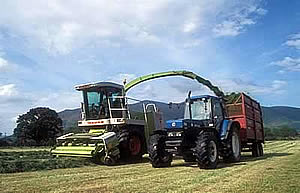 |
|||||||||
|
|||||||||||||||||||
New
Guide Highlights Mycotoxins Risk From Drier Grass Silage High dry matter silage that is prevalent on many dairy farms this year following an exceptionally warm and dry grass harvest presents a greater risk of mycotoxins contamination, according to a new technical guide launched by Alltech at Dairy Event 2006.
Difficulties of consolidating drier material in the clamp, leading to greater air ingress and more potential mould growth, mean farmers should be all the more aware of the hidden threat of mycotoxins this autumn, said the company’s ruminant technical manager David Wilde at the event. “High dry matter silage is one of a number of risk factors that we identify in our new guide,” he explained. “Some of the early reports that I have seen on this year’s silage quality are indicating a significant increase in dry matters across the country, with average figures in the 33-35% range. “Consolidation of material in clamps will have been more difficult and there will inevitably be some who will find their silage is more susceptible to mould, and this can result in mycotoxins in the feed. “Good face management will be all the more important to minimise the risks, including keeping the exposed face to a minimum and ensuring that it is cut as cleanly and tidy as possible. Farmers must however be aware that moulds may develop within the clamp, and not only at the face, and that an absence of visible mould is no guarantee of freedom from mycotoxins.” In addition to a full explanation of the origins of mycotoxins and their many and varied effects on ruminant livestock, Alltech’s new guide includes a section that allows farmers to conduct their own risk assessment. “Mycotoxins are a relatively new and complex phenomenon for dairy farmers so we are sure that the guide will be a valuable aid,” said David Wilde. “One of the main difficulties is that mycotoxins are a potential problem anywhere that mould can grow, and that includes all feeds and fresh feed sources. Some mycotoxins originate from moulds that grow on crops in the field, and will survive the silage fermentation process, so may be present in the feed even if there is no visible evidence. “We hope that by identifying many of the symptoms and making recommendations on how to deal with a suspected presence that we can help a lot of farmers combat the threat before it becomes costly.” Free copies of “A Guide to Mycotoxins in Ruminants” were available to dairy farmers on Alltech’s stand at Dairy Event 2006 in Cattle Shed 3 (stand 553), and can also be obtained by contacting Alltech UK on 01780 764512.
|
|||||||||||||||||||

|
|
||||||||||||||||||
| home | agri-services | pedigree
pen | news | dairy | beef | machinery quota | property | organisations | site map |
|||||||||||||||||||

